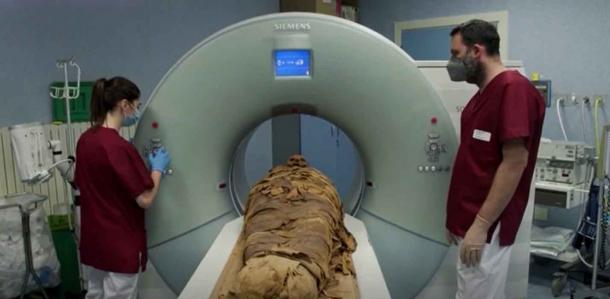A known Egyptian priest mummy, from over 3,000 years ago, has recently been transferred from Italy’s famous Museum of Civil Archeology in Bergamo to the Policlinico of Milan hospital to conduct a mummy CT scan. Researchers at Milan’s prestigious Mummy Project are hoping to learn more about the ancient priest’s life, health, and mummification, according to a Reuters news report.

Italian archaeologist Sabina Malgora, director of the Mummy Project, standing in front of one of the many mummies her team has examined. ( Mummy Project )
The Egyptian Mummy Priest and Italy’s Mummy Project
Part of ongoing research conducted by Italy’s prestigious long-term Mummy Project , the CT scans (and other related projects) are being conducted by a team of experts working in Milan. Their chief purpose is to “facilitate the study of ancient organic remains and especially human and plant mummies” using advanced techniques of medical and forensic investigation . “The mummies are practically a biological museum, they are like a time capsule,” said archaeologist Sabina Malgora, who is the director of the Mummy Project.
The Mummy Project’s mission statement emphasizes that the research on ancient mummies in no way disturbs, injures, or changes the body being examined in any way. Over the previous decade, their landmark research and methodology has helped establish a vast and rich network of resources, presented in the form of events and cultural displays across museums, foundations, and libraries all over Europe.

Here the Egyptian priest mummy is about to “enter” the CT scan machine in Milano, Italy. (video clip image / Reuters)
Priest Ankhenkhonsu’s Mummy: Medical History and Disease
The Egyptian priest ’s name, Ankh Khonsu or Ankhekhonsu, which translates as “the god Khonsu who is alive,” was written on the sarcophagus in five different places!
The research team is confident that their high-tech research will help them to better understand the materials and overall process used to mummify the body. Egyptian mummification processes are still an “open” age-old question that has generated a lot of debate, discussion, and research in the field of history and archaeology.
Modern mummy analyses, including those for bones, teeth, hair and preserved soft tissue , have provided a wealth of information on the health of the deceased, and other important information like the food they ate.
Moreover, a considerably detailed medical history for both diseases and injuries can be ascertained with high-tech scans. Ms. Malgora stated, “Studying ancient diseases and injuries is important for modern medical research . We can study cancer and atherosclerosis in the past and that could be useful for modern research.”
This is not the first instance of modern technology meeting the ancient world. In 2008, a CT scan performed on another mummy (a female) revealed a brain-removal tool used by ancient Egyptian embalmers, which was lodged in her skull dating back to around 2,400 years ago, as per a report on Yahoo News!

Priest Ankhenkhonsu’s mummy, as it was in the sarcophagus when first discovered, about to enter the CT-scan machine. (video clip image / Reuters)
The Mummies of Ancient Egypt
Mummies, along with the pyramids , are the most popular modern-day references to Egypt’s great ancient river civilization, which thrived along the Nile River Nile for millennia (and still does today!). The word mummy is derived from the Persian or Arabic word mumia (or mumiya), which means “pitch” or ” bitumen,” which originally referred to a black, asphalt-like substance thought to have medicinal properties. It was eagerly sought as a cure for many ailments. Since Egyptian mummies are black appearance, the word became associated with them.
The science of mummification was remarkable for its time given that dehydration of the tissues was used to prevent putrefaction. In ancient Egypt, mummification became an integral part of death rituals as early as 2800 BC. Preservation of elite bodies was seen as important for living well in the afterlife.
For this reason, the internal organs were removed first. And then the body was doused with wine and spices. Interestingly, the heart was left inside as it was seen as vital in the afterlife. This was because the Egyptians felt the seat of feeling and thought was the heart.
After dehydrating the body, it was wrapped in several layers of linen and sometimes amulets were added to protect the departed soul from evil.
Over time, the wealthier classes began to adopt mummification and, eventually, a hierarchy of entombing and embalming the elite dead developed.
Today, we have a long list of celebrated mummies who are overwhelmingly pharaohs, like Tutankhamen, or members of the royal family.
Top image: Researchers at the Mummy Project of Milan, Italy around an Egyptian mummy about to enter a CT scan. Earlier this year, Mummy Project researchers began their examination of a famous priest mummy, hoping to learn more about his life, health, and mummification. Source: Mummy Project
By Rudra Bhushan
Related posts:
Views: 0
 RSS Feed
RSS Feed















 July 13th, 2021
July 13th, 2021  Awake Goy
Awake Goy  Posted in
Posted in  Tags:
Tags: 
















